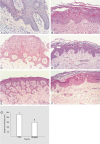Recent advances on the roles of epidermal growth factor receptor in psoriasis
- PMID: 30899359
- PMCID: PMC6413281
Recent advances on the roles of epidermal growth factor receptor in psoriasis
Abstract
Epidermal growth factor receptor (EGFR) is a well-characterized receptor tyrosine kinase that involved in many vital activities in cell development, such as cellular homeostasis, proliferation, division, differentiation and apoptosis. Natural activation of EGFR and the concomitant downstream signaling pathways regulation are substantial to maintain normal cellular functions. In recent studies, EGFR was demonstrated to be a fundamental modulator in the control of skin inflammatory responses. Several dermatologic diseases including psoriasis are related to the anomalous activation of EGFR signaling. It has been proved that the expression and activity of EGFR and its endogenous ligands are overexpressed in the active epidermis lesions of psoriasis. Moreover, the remarkable therapeutic improvement of chronic psoriasis in cancer patients during the treatment of EGFR inhibitors or anti-EGFR monoclonal antibodies are also recorded, suggesting that the EGFR-mediated signaling may conduct a crucial role in the pathophysiology of psoriasis.
Keywords: EGF; EGFR; keratinocytes; psoriasis.
Conflict of interest statement
None.
Figures




References
-
- Pastore S, Lulli D, Girolomoni G. Replica to K. Takeda et al. commentary to Pastore et al. (2014): epidermal growth factor receptor signalling in keratinocyte biology: implications for skin toxicity of tyrosine kinase inhibitors. Arch Toxicol. 2014;88:2321–2322. - PubMed
-
- Nanba D, Toki F, Barrandon Y, Higashiyama S. Recent advances in the epidermal growth factor receptor/ligand system biology on skin homeostasis and keratinocyte stem cell regulation. J Dermatol Sci. 2013;72:81–86. - PubMed
-
- Michalek IM, Loring B, John SM. A systematic review of worldwide epidemiology of psoriasis. J Eur Acad Dermatol Venereol. 2017;31:205–212. - PubMed
-
- Boehncke WH, Schön MP. Psoriasis. Lancet. 2015;386:983–994. - PubMed
Publication types
Grants and funding
LinkOut - more resources
Full Text Sources
Other Literature Sources
Research Materials
Miscellaneous
